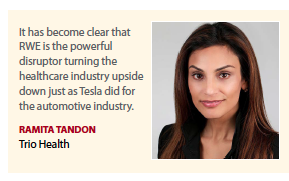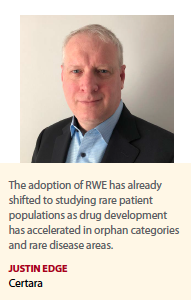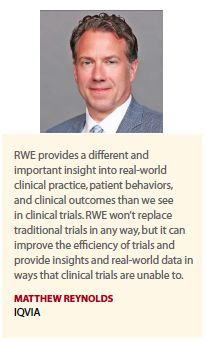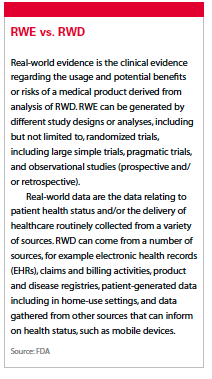Real-world evidence, important for regulatory decision-making, is beginning to touch all areas of the healthcare value chain.
Historically, real-world evidence (RWE) and real-world data (RWD) have been used for postmarket safety monitoring, but now sponsors are beginning to use these data sets to support clinical trial design and observational studies to generate better treatment approaches, while healthcare systems are collecting and using RWE to substantiate coverage decisions. Increasingly, RWE/D is being used to monitor postmarket safety and adverse events and to make regulatory decisions. The FDA says the healthcare community is using these data to support coverage decisions and to develop guidelines and decision support tools for use  in clinical practice. Medical product developers are using RWE/D to support clinical trial designs (e.g., large simple trials, pragmatic clinical trials) and observational studies to generate innovative, new treatment approaches.
in clinical practice. Medical product developers are using RWE/D to support clinical trial designs (e.g., large simple trials, pragmatic clinical trials) and observational studies to generate innovative, new treatment approaches.
The 21st Century Cures Act, which was passed in 2016, places additional focus on the use of these types of data to support regulatory decision making, including approval of new indications for approved drugs. Under the act, RWE was redefined as data regarding the usage, or the potential benefits or risks, of a drug derived from sources other than traditional clinical trials. The FDA expanded on this definition to include the use of computers, mobile devices, wearables, and other biosensors to gather and store huge amounts of health-related data. These data sets hold the potential for researchers to better design and conduct clinical trials and studies to answer questions previously thought infeasible. The FDA says in addition, with the development of sophisticated, new analytical capabilities, it’s better to be able to analyze these data and apply the results of analyses to medical product development and approval.
A recent Deloitte study found companies that have invested in mature RWE capabilities are seeing returns. Further, RWD and RWE remain a C-suite strategic priority for pharmaceutical companies. More than 40% of this year’s respondents say recent FDA guidance and statements encouraging RWE use in R&D are driving an increased strategic focus. Others pointed to mounting pricing and market access pressures, the rising cost of drug development, or a combination of these factors driving C-suite focus.
Deloitte analysts say “the future is already here — it is just not evenly distributed." They says this perfectly describes the status of RWD and RWE capabilities across pharmaceutical companies in 2020. Survey results clearly demonstrate that some respondents are further ahead in terms of investing and realizing value from RWE capabilities compared with their peers.
 At the same time, the industry has yet to realize the full potential of RWE in transforming how medicines are developed, commercialized, and reimbursed, Deloitte analysts say. Mature companies have demonstrated that a strong foundation with centralized technology platforms and governance is a critical first step. To capitalize on the power of real-world evidence, companies should also define a clear enterprisewide strategy for their RWE investments inclusive of innovation pilots, a framework to measure ROI, challenge conventional thinking, and engage with the healthcare ecosystem in new ways to elevate RWE’s impact across the continuum.
At the same time, the industry has yet to realize the full potential of RWE in transforming how medicines are developed, commercialized, and reimbursed, Deloitte analysts say. Mature companies have demonstrated that a strong foundation with centralized technology platforms and governance is a critical first step. To capitalize on the power of real-world evidence, companies should also define a clear enterprisewide strategy for their RWE investments inclusive of innovation pilots, a framework to measure ROI, challenge conventional thinking, and engage with the healthcare ecosystem in new ways to elevate RWE’s impact across the continuum.
“After spending two decades in the CRO industry pushing RWE as part of the innovation journey in postmarketing, then making that proverbial leap to the other side of the fence to a RWE healthcare technology firm, it has become clear RWE is the powerful disruptor turning the healthcare industry upside down, just as Tesla did for the automotive industry," says Ramita Tandon, chief operating officer, Trio Health. “RWE is now being leveraged beyond postmarket safety monitoring to unlock a new and deeper level of transparency for better understanding of disease progression, treatment pathways, and patient reported treatment gaps to drive increased connectivity between all stakeholders."
These firsthand insights, she says, allow the stakeholders to educate, learn, and deploy more tailored patient-centric strategies across the product’s life cycle, including patient educational programs. “It is this continuous RWE feedback and improvement loop that is paramount to spur collaboration and create the foundations to address the current healthcare dynamic that is powering a shift towards personalized, value-based treatment," Ms. Tandon says.
Leveraging a variety of innovative technological solutions for data collection allows researchers to get timely data collection directly from the patients at their convenience.
“There is a large amount of important clinical information and patient-reported endpoints, that we obtain directly from the patients themselves without burdening a healthcare practitioner," says Matthew Reynolds, VP, real world evidence at IQVIA.
Access to this data will become critical in the coming months and years as COVID-19 continues to dominate the news. RWD and RWE will lead to a clearer understanding of the long-term impact of the virus.
“Like most of the world, we are also focused on COVID-19, and RWD/RWE is key in driving effective insights and solutions for our pharmaceutical, regulatory, and clinical stakeholders," Mr. Reynolds says. “We are using RWD to evaluate near real-time treatment patterns and clinical outcomes in COVID-19 patients. We have created a COVID-19 registry, CARE — www.helpstopcovid19.com — to generate additional RWD that isn’t available elsewhere, including treatments like OTC medications and vitamins/minerals/supplements as well as detailed symptom data over time. We have designed and are in the process of implementing several innovative COVID-19 vaccine surveillance solutions for the eventual vaccine rollout. Real-world data has allowed us to be proactive, nimble, and responsive in a way that we wouldn’t have been able to do via traditional clinical data collection methods."
Justin Edge, Certara president, regulatory and commercial sciences, says a benefit of RWE adoption has been a shift to studying rare patient populations as drug development has accelerated in orphan categories and rare disease areas.
“We continue to focus on traditional applications for RWE, such as safety/risk assessments, epidemiology, disease burden, and health resource use; but we are also seeing a growing interest in upstream applications, such as external controls for single arms trials, informing the right patient-reported outcomes instruments for clinical trials, and optimizing clinical trial design," he says. “We also anticipate a growth in downstream applications, such as predicting and policing the effectiveness of medicines governed by innovative payer contracts. This will be the norm for high-cost, high-impact gene therapies."
Mr. Reynolds agrees there are also more opportunities today to leverage RWD as part of effective R&D for rare disorders and/or complex diseases where patient recruitment to a randomized study may be difficult, unethical, or near-impossible.
“Leveraging real-world data to construct an external comparator for a single arm study has been proven to be effective for a number of regulatory approvals worldwide," he says. “There is also growing interest in conducting pragmatic clinical trials during or immediately after Phase III clinical trials are complete.
While this approach does employ randomization of a treatment of interest, usually to standard of care, not placebo, it typically leverages much broader inclusion/exclusion criteria, more focused data collection, and less clinical treatment/follow-up rigor as compared with a traditional clinical trial. Effective implementation and delivery of these methods requires the expertise of both traditional R&D and RWD data and methodologies."
RWE and R&D
RWE has the ability to inform, augment, strengthen, and complement traditional approaches to R&D.
“RWE provides a different and important insight into real-world clinical practice, patient behaviors, and clinical outcomes than we see in clinical trials," Mr. Reynolds says. “RWE won’t replace traditional clinical trials in any way, but it can improve the efficiency of trials and provide insights and real-world data in ways that clinical trials are unable to."
For R&D, the value of RWE continues to be an area of great interest especially to transform the clinical trial value chain productivity through patient cohort identification, facilitate new trial designs — for example pragmatic trials and synthetic RWE arms — look at ways for the study protocols to align with real-world clinical treatment pathways, and to support enhancement and label expansions, Ms. Tandon says. “The goal for RWE is for clinical teams to align product development with specific unmet patient needs and hidden value opportunities," she adds. “The dynamic healthcare environment is a call to action for the industry to rethink the traditional R&D approach. The collaboration among the stakeholders is key to operationalize real-world evidence to inform product development innovation. The R&D path can be simplified and enhanced by strengthening the connections between the historically independent R&D, medical affairs, and commercial organizations to uncover the patient voice and address the patient’s most pressing needs."
Ms. Tandon believes a R&D model that brings the patient voice to the process ensures a more accelerated path to commercialization. “Securing early real-world insights can accelerate research and early development through more informed decision making and help identify potential future scenarios that may influence stakeholders at launch," she says. “This can enable manufacturers to collect the appropriate evidence package at the right time and through the most efficient strategies."
 To this end, use of RWE could have a valuable role in transforming the R&D model in several areas including evolving the clinical operations function that uses a robust evidence management engine with access to the physician office and the patient voice. “Such a robust engine should be part of the DNA for every aspect of trial operations to unlock hidden opportunities for efficiencies in protocol design, site selection, patient recruitment, and source data monitoring and verification," she says.
To this end, use of RWE could have a valuable role in transforming the R&D model in several areas including evolving the clinical operations function that uses a robust evidence management engine with access to the physician office and the patient voice. “Such a robust engine should be part of the DNA for every aspect of trial operations to unlock hidden opportunities for efficiencies in protocol design, site selection, patient recruitment, and source data monitoring and verification," she says.
Additionally, RWE could create an opportunity to build an active surveillance registry to enhance pharmacovigilance operations and proactively improve patient safety.
“A unified structured insight-driven safety platform that detects, analyzes, and aggregates safety signals will represent a game changer for R&D by allowing the pharmacovigilance teams to be proactive and agile to react as quickly as possible to identify safety trends and in turn increase regulators’ confidence in a drug’s safety profile," Ms. Tandon says.
Because there are myriad ways to leverage RWD and RWE for R&D with the underlying goal to be more efficient and effective at identifying the right patients and collecting high quality data, Mr. Matthews says using RWD at the outset of a prospective study allows for the confirmation that the inclusion/exclusion criteria are realistic and effective.
“It allows companies to better understand the natural history of disease, meaning there are better insights into real-world treatment patterns, the expected rate of clinical events of interest, and progression of disease," he says. “Having these insights allows for optimal study design with regards to entry criteria, treatment comparators, meaningful clinical endpoints, and realistic and effective sample size estimates. Further, existing real world data can then be used to apply those criteria to better identify and enroll the right patients for the study."
It’s well-known that R&D has become a very expensive proposition with high risks of failure, patient recruitment challenges — especially for rare conditions — even more so in a pandemic — and assertive regulators.
“RWD, and the evidence it generates, helps to decode drug performance under different real-world conditions, incorporating health system effects or non-clinical patient behavior," Mr. Edge says. “It can inform subsequent drug development programs, for example, complementing clinical development with adaptive trial design or the use of synthetic/external control arms. RWD/RWE can also be useful in late-phase R&D, helping to reduce the burden of regulatory  commitments such as post-authorization safety studies. Bottom line, RWD/RWE help accelerate time to market, which is a positive for industry and patients alike."
commitments such as post-authorization safety studies. Bottom line, RWD/RWE help accelerate time to market, which is a positive for industry and patients alike."
RWE’s Impact on Commercial Activities
With changing commercial models RWE is becoming more important for launch excellence and is a true strategic differentiator.
“RWE is uniquely suited to overcome hurdles to achieve commercial success: convincing relevant stakeholders and decision makers of the benefits and value a new product offers, confirming its safety and explaining how it fits with current clinical practice and within the existing treatment landscape," Mr. Reynolds says. “Its distinctive feature of capturing patient-level observations in routine clinical practice allows RWE to bridge the evidence gap left by randomized clinical trials due to their inherent limitations, such as being highly controlled and thus unrepresentative of real-world patient populations, or practice."
According to Ms. Tandon, at the time of an early R&D phase, RWE can demonstrate how to support asset prioritization and help identify potential opportunities for indication expansion once the patient voice is uncovered.
“This enables us to understand why patients switch or discontinue therapy, while also being able to review the historical trends that may be impacting the actions," Ms. Tanden says. “RWE can support commercial goals by leveraging the real-world insights from the patient voice and clinical data as this combination offers quicker and deeper insights, which stakeholders can use to craft and implement more tailored strategies, like the patient education needed to accelerate optimizing physician and patient experiences and outcomes. For example, we can use the patient switching and discontinuation reasons to support the need to quantify the real-world treatment effectiveness and in turn support value-based contracting discussions with payers."
Mr. Edge says while RWD/RWE have always been an integral part of many health technology assessment (HTA) processes, helping authorities to understand the cost-effectiveness and budget impact of new drugs, but by harnessing these approaches, RWD can be used to design innovative risk-sharing contracts and ultimately to keep track of the outcomes.
“ICER and other third-party review bodies are paving the way for HTA methodologies to find their way into the North American and APAC markets," he says.(PV)
~~~~~~~~~~~~~~~~~~~~~~~~~
RWE vs. RWD
Real-world evidence is the clinical evidence regarding the usage and potential benefits or risks of a medical product derived from analysis of RWD. RWE can be generated by different study designs or analyses, including but not limited to, randomized trials, including large simple trials, pragmatic trials, and observational studies (prospective and/or retrospective).
Real-world data are the data relating to patient health status and/or the delivery of healthcare routinely collected from a variety of sources. RWD can come from a number of sources, for example electronic health records (EHRs), claims and billing activities, product and disease registries, patient-generated data including in home-use settings, and data gathered from other sources that can inform on health status, such as mobile devices.
Source: FDA
~~~~~~~~~~~~~~~~~~~~~~~~~
![]() RWE: Trend Tracking
RWE: Trend Tracking
94% of Deloitte survey respondents believe using RWE in R&D will become important or very important to their organizations by 2022.
Survey respondents expect a shift in the application of RWE in the next two to three years with the highest impact being in R&D, including supporting regulatory filings and augmenting clinical trials, in contrast to the more traditional applications where they realize value today.
Most respondents expect a wide range of benefits from using RWE in R&D. So far, the biggest gains have come in the form of cost reduction in postmarketing commitments and executing clinical trials.
70% say a lack of research-grade data is hindering RWE efforts in R&D. This emphasizes the importance of establishing strategic partnerships. More than 80% of surveyed companies are entering into strategic partnerships to access new sources of RWD.
Almost all companies expect to increase investments in talent, technology, and external partnerships to strengthen their RWE capabilities.
Source: Deloitte


















